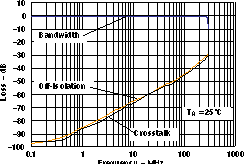SCDS252B July 2007 – June 2021 TS5A23157-Q1
PRODUCTION DATA
- 1 Features
- 2 Applications
- 3 Description
- 4 Revision History
- 5 Pin Configurations and Functions
- 6 Specifications
- 7 Parameter Description
- 8 Parameter Measurement Information
- 9 Function and Summary of Characteristics
- 10Detailed Description
- 11Application and Implementation
- 12Power Supply Recommendations
- 13Layout
- 14Device and Documentation Support
- 15Mechanical, Packaging, and Orderable Information
Package Options
Mechanical Data (Package|Pins)
- DGS|10
Thermal pad, mechanical data (Package|Pins)
Orderable Information
11.5 Application Performance Plots
Three important parameters when using the TS5A23157-Q1 in any communication protocol / GPIO switching application are the bandwidth of the switch as well as off isolation and cross talk. The below figure shows the typical bandwidth, off isolation, and cross talk versus frequency. When implenmenting this use case of the switch it is crucial to understand the AC error that other signals may create when using this device.
 Figure 11-2 AC Parmeters for TS5A23157-Q1
(V+ = 3V)
Figure 11-2 AC Parmeters for TS5A23157-Q1
(V+ = 3V)